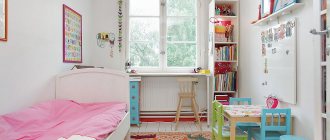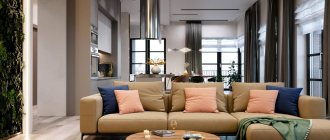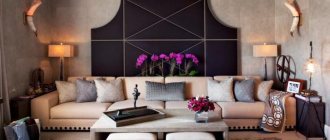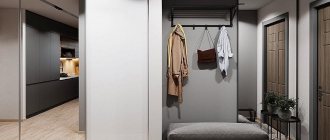A guest room is a separate room that is reserved specifically for guests staying for a while. The main purpose of its arrangement is the desire of the owners to create the necessary conditions for a comfortable stay for loved ones who decide to stay longer. Do not confuse the guest room with the living room. The second room is the room where everyone gathers for gatherings and spending leisure time together. The guest room has a bed for an overnight stay, a wardrobe and storage space, that is, in essence, it is a separate area designed for one or two people, which serves as an alternative to a room in a hotel or hotel. Each of us is often visited by distant relatives or loved ones living in another city, old friends who have been scattered by life. They always want to provide a “high level” reception, making their guests truly feel at home. The design of the guest room is universal, since different people with their own tastes and preferences will live in it. Therefore, neutral styles are usually chosen for its design, but we will talk about this later.
Conditions for creating a room
Of course, not everyone can afford a separate room, which will be empty most of the time. In apartments, the area is already clearly divided into certain zones and finding a place for guests is very problematic. The established layout with a bedroom, living room, kitchen and nursery does not imply such chic as an “extra room”. As an alternative, a separate area in the largest room (usually a hall) is suitable, which will be separated from the main part by partitions, arches, furniture or decorative walls.
In private homes, it is much easier to allocate space for guests. There are usually more rooms there, and at least one room, albeit tiny, can be converted into living space. In luxury cottages and mansions, owners can afford to design an entire “studio apartment” with a separate bathroom and toilet, so that there is no line in the morning for the shared bathroom.
Guest rooms usually have a very unattractive location: lack of light, shortage of square meters, not the most original economical interior. The reason for this is their rare use. To create a truly original, but cozy design and at the same time play up all the shortcomings of the room, disguising them and partially turning them into advantages, the designer will have to work hard.
In the apartment
Owners of standard apartments are unlikely to have to boast of space. The design of a guest room in conditions of limited square footage is not distinguished by sophistication and variety.
Visitors are most often seated in the hall. Of course, it is impossible to predict the number of people in advance. But it is still possible to accommodate a family of three if you install a folding sofa or armchair in the living room.
A folding sofa is a practical option, proven by more than one generation of people.
An excellent solution would be to purchase transformable furniture, for example, a wall with a folding bed
If guests come quite often, it is appropriate to divide the hall into functional areas. This is done using plasterboard partitions, translucent curtains, folding screens, mobile shelving, and shelves on wheels that can be easily dismantled.
The easiest way to separate the guest area is to hang a curtain on the ceiling cornice
This method will allow you to fence off the resting space for temporary guests, leaving space for watching TV shows together, having morning tea or evening gatherings on the occasion of a special meeting. And also organize a place to store their things, temporarily freeing up for these purposes, for example, a chest of drawers or highlighting a couple of shelves in a furniture wall.
Requirements for arranging a guest room
When creating the interior of a guest room, you need to take into account a number of nuances that will help you find the right vector:
- A guest room most often has small dimensions, but the optimal size is considered to be an area of at least 10 sq.m. If the room’s square footage does not reach this figure, then a person will not feel comfortable in it.
- It is imperative to provide generous artificial lighting when natural lighting is in short supply.
- The minimal furniture set includes a bed, a wardrobe, a bedside table (dressing table) or a chest of drawers with a mirror. In more spacious rooms, this set can be supplemented with shelves with books, an armchair and even a fireplace for special comfort. In small rooms, it may be worth considering multifunctional furniture to save space.
- We must not forget about entertainment, so a TV must be installed in every guest room.
- It is desirable to have a separate bathroom.
To better navigate when creating decorations, study interior solutions in hotel rooms.
Furnishings
Don't get too carried away with furnishing the guest bedroom. To arrange all the things of the temporary inhabitants of the house in a standard bedroom, the following is quite enough:
- Beds;
- Wardrobe;
- Pairs of bedside tables.
In a spacious room you can additionally install a chest of drawers.
If you have doubts about the need to install additional items, you can look at the furnishings of hotel rooms. There is everything you need for life here, but at the same time the room looks spacious and comfortable enough for living.
Nice decor will help remove the feeling of a public space.
About lighting
As for lighting, guests are given the opportunity to independently adjust both types: artificial and natural. In the first case, in addition to the central ceiling chandelier, the room is equipped with local fixtures (sconces, floor lamps, lamps) and decorative light bulbs around the perimeter. So that a person can customize the lighting to suit himself, it is advisable to equip the system with a control panel that will allow you to adjust the intensity. Guests can come not only from a neighboring village or suburb, but also from another country with a completely different time zone.
During the acclimatization period, a person will initially have the habit of sleeping at unusual times for others. Therefore, be sure to hang thick curtains so that the fabric reliably protects the sleeper from sunlight. Alternatively, you can leave a special night mask-glasses on your nightstand. The tulle is chosen to be translucent, since perhaps the guest (city dweller) likes to fall asleep under the lulling light of street lamps.
Style and color scheme
From the stylistic variety, they try to choose neutral, cozy options:
- Provence . It is characterized by a light, “homey” interior, which will be comfortable for people of different ages. The interior uses a lot of white, aged furniture, and decorative vases with fresh flowers.
- Classic style. This direction is considered a traditional one. The classics have luxury, elegance, and special beauty. The walls are covered with wallpaper with floral patterns, surfaces are decorated with stucco and bas-reliefs, furniture facades are decorated with carvings and ornate, elegant details.
- Modern. The style is distinguished by rationality and simplicity. It uses chrome surfaces, metal, wood, heavy-duty plastic and glass. The color scheme is dominated by white, gray and contrasting black, blue, and purple in details and accent elements.
- Scandinavian. The style is classified as neutral. It is good for a guest room because it will help smooth out the lack of space in the form of a lack of natural light. The interior uses an abundance of white, cool tones, a minimum of furniture and a small amount of natural decor: a soft carpet on the floor, animal skins and deer antlers, a series of original photographs on the walls.
- Neoclassical. The direction is based on the rules of the traditional classical style, but at the same time it is adapted to the modern person.
A combined version is also used as a universal design. For it, they take the best from different directions, carefully develop the principle of combination and implement it in a “free” interior. As for the color scheme, again it is better to stick to a neutral palette. White predominates in it, and any pastel shade is chosen for the role of the second member of the trio. The third, accent tone can be a contrasting, bright color: purple, lilac, turquoise, blue, yellow. In small rooms, space is increased with light shades, while in large rooms it can be balanced with large prints and a dark palette.
When choosing a range, do not forget that the guest room is designed for relaxation. Therefore, you should not overdo it with dark, gloomy tones, which will create the same atmosphere. The room should be conducive to sleep and relaxation. According to color psychology, warm shades are suitable for these purposes.
Finishing wall panels
Almost all known materials can be used to decorate the walls of the living room. You must first familiarize yourself with the features of the chosen interior style and select finishing compounds and coatings.
The most optimal coverings for arranging a guest room are the following:
- Wallpaper (classic paper, vinyl and non-woven, luxury textile, liquid and fiberglass). Bamboo and cork coverings, which have excellent environmental performance and a pleasant design, can be used to decorate one of the walls.
- Beautiful decorative plaster, which is available in a wide range of colors, allows you to hide small defects on the underlying surfaces, is quite durable and easy to maintain.
- Plaster, plastic and wooden panels with various patterns, reliefs, and textures are also used to create a pleasant living room design in a private home.
For some interior styles, brick and stone masonry are used (for example, Loft). The living room has an advantageous design, made in the style of a hunting lodge, where the walls and ceilings are made of wooden logs.
Decor and choice of textiles
You can’t decorate a room with an abundance of decor. Remember the neutrality of the guest book. A couple of pillows on the bed with original pillowcases, a series of paintings or original photos on the walls, a few trinkets and indoor plants will be enough. When choosing the latter, try to give preference to hypoallergenic ones without flowers, as some guests may have allergies. Also, don't hang your family photos on the walls.
The guest room should not be associated with the owners of the house, because otherwise the resident will have an unpleasant feeling of intrusion into someone else's private life on a subconscious level. This will negatively affect comfort. Neutral options are chosen as the subject of paintings and photographs: sea and forest landscapes, reproductions of paintings by famous masters, abstract compositions. The decor should only emphasize the design style. In textiles, it is better to choose natural fabrics (remember about allergies) with a simple texture, without excessive luxury, because this is a guest room, not a museum.
Furniture selection
A bed, chair or pouf, dressing table and wardrobe are required. If the space of the room allows, then it is better to add a corner for leisure, where you place a shelf with books, a miniature coffee table and an armchair or couch. There is a separate cabinet or niche for the TV. Alternatively, it can be hung on the wall opposite the bed.
If the room is very small, then use a built-in wardrobe. It is a great space saver, and during “non-reception” periods they put their own things here, which temporarily have nowhere to hide. In very tiny rooms, multifunctional furniture is used. During the day, the bed can turn into a sofa or even “hide” in a closet. The table can be pulled out if necessary, and the chairs can be folded up like garden chairs and put away in niches specially designated for these purposes.
Built-in wardrobes
The classic combination of black and white can also look unusual
If it is possible to create a niche in the wall, you need to take advantage of it and install a built-in wardrobe. Then the room is guaranteed to have more space. And if the cabinet doors are mirrored, the illusion of even more space will arise. A black and white striped carpet will also help to visually expand the room.
Option with one bed
The bed will be the center of the guest room. It personifies the main purpose of this room. Guests can sleep here or just “lounge” after a long journey. You should not choose “experimental” options in the form of round or “water” beds. Some people may not like this innovation. Wood is considered the best material for a bed. This beautiful material is welcome in any style and will give guests a sense of security. Solid wood can be supplemented with forged elements.
Option with two or more beds
The situation is much more complicated with rooms designed for a couple of guests or more. It’s good if a married couple arrives, but what do you do when you need to put a guy and a girl who didn’t even know each other in the same room? Of course, the compact, but completely inappropriate in this case, option with bunk beds is not even considered. Linear placement along one wall is considered optimal. In this case, the beds can be separated if necessary.
In order not to complicate the interior with massive zone dividers, it is recommended to use mobile partitions, curtains or screens. If necessary, each sleeping place is fenced off. During the day, the room is freed from partitions, and its interior again becomes a single composition. Of course, there can be no talk of any sound insulation. You have to either be content with what you have, or design several separate guest rooms, which not everyone can afford.
Think deeper
These days, exposed brickwork is considered a highlight rather than a design flaw.
If it is not possible to hang standard shelves, then why not create niches in the walls? After all, in this way space will be saved and the design will acquire character. True, this approach is not applicable to all walls, so you cannot do without prior consultation with a specialist.
A few words about the guest house
A guest house or guesthouse is a euro option that has become an alternative to hotel rooms. In our country they are very rare due to the lack of such a tradition. This is a separate building, usually small in size, in which guests live completely separate from the owners. Of course this is not a hut or a shack. The guest house is furnished with all amenities. At worst, there is a bathhouse and a comfortable toilet nearby on the site, which has nothing in common with the rickety “booths”.
Guest houses are usually built from logs and are vaguely similar to temporary cottages. They use a typical layout: a terrace, one or two bedrooms, an entrance hall and a miniature kitchenette for making coffee in the morning or late-night snacks. The standard set of household appliances includes a kettle, microwave, refrigerator, washing machine, iron and TV. It is not recommended to fill a room with furniture, since large space is the main advantage of houses over rooms, which is why they are good.
The guest room is a vital space for hospitable hosts who want to show guests a special sign of respect for their personal space. Its main difference from a standard hotel room is its special home comfort. When decorating a room, you need to furnish it in such a way that you feel concern for the comfort of others, but without the presence of the owner’s personality in the details.











